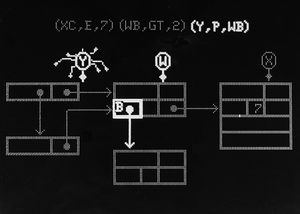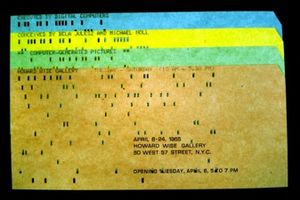First-Hand:Early Digital Art At Bell Telephone Laboratories, Inc
Copyright
Written by A. Michael Noll, February 2nd, 2014
Copyright © 2014 A. Michael Noll
This history by A. Michael Noll was published in LEONARDO, the official journal of the International Society for the Arts, Society and Technology: “Early Digital Computer Art at Bell Telephone Laboratories, Incorporated,” LEONARDO, Vol. 49, No. 1 (2016), pp. 55-65.
Abstract

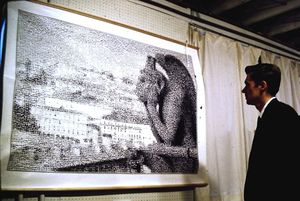
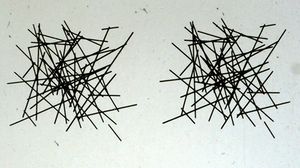
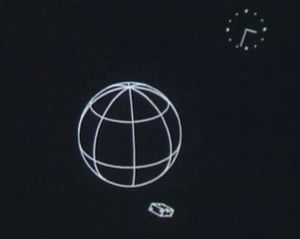
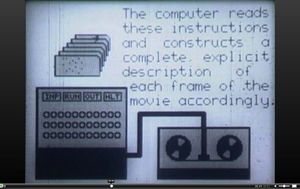

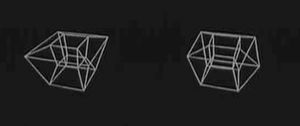
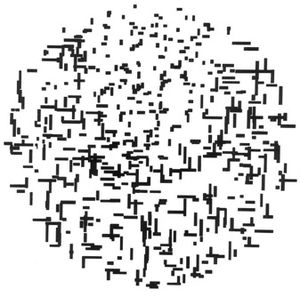
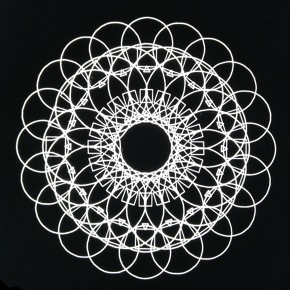
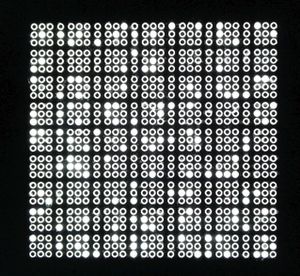

This article is a history, of the digital computer art and animation that was developed and created at Bell Telephone Laboratories, Incorporated (or simply, Bell Labs) from 1962 to 1968. Still and animated images in two dimensions and in stereographic pairs were created, along with their use in investigations of aesthetic preferences and their application to film titles and choreography. Interactive digital computer music software was extended to the visual domain, including a real-time interactive system. Some of the art works generated were exhibited publicly in major art venues in 1965, and then many were shown extensively in subsequent years. This pioneering work at Bell Labs was a significant contribution to digital art.
Introduction
Early pioneering research into digital computer art and artistic animation was done at Bell Telephone Laboratories, Inc. at its Murray Hill, NJ facility during the 1960s. This article is a history of that research at Bell Labs, focusing on the formative period from 1962 to around 1968. The emphasis of this history is on the actual employees of Bell Labs who contributed to both the digital art and the technology.
By the late 1960s, digital computer art was fairly well established, with artists, animators, and conferences around the planet – although as a technology-based art medium, it continued to evolve thereafter both with the technology it employed and with the aesthetics of the era. Given all of today’s extensive use of computer graphics, it is hard to imagine that in the 1960s the use of graphics as output from computers was novel and innovative.
The history in this article is concerned solely with the early work that was performed at Bell Telephone Laboratories, Inc. related to the visual arts. However, others also did early work in computer art and animation during the 1960s, such as Frieder Nake and Georg Nees in Germany, Leslie Mezei in Toronto[1], John Whitney, Sr., and William Fetter at Boeing. Conferences were being held and books were being written by the second half of the 1960s, such as the one organized in 1966 by Martin Krampen at the University of Waterloo in Canada,[2] the 1968 book and exhibition Cybernetic Serendipity by Jasia Reichardt in London,[3] and Tendencies 4: Computers and Visual Research in Zagreb in 1968.The Computer Arts Society first met in London in 1968. [4]
Bell Telephone Laboratories, Incorporated (or simply, “Bell Labs”) was the research and development entity for AT&T’s Bell System. AT&T and the Western Electric Company (the manufacturing entity for the Bell System) jointly owned Bell Labs. The basic research done at Bell Labs was roughly about five percent of its work and was mostly financially supported by AT&T and the local telephone companies. Dr. William O. Baker was Vice President, Research and Dr. John R. Pierce was Executive Director of the departments where most of the research in digital art was performed.[5][6] These two individuals are featured in two recent books about Bell Labs, and their support of digital art and animation was crucial.
The work in digital art at Bell Labs was both an application from research in computer graphics and also a stimulus for that research. As an R&D organization, Bell Labs was keenly interested in the display of scientific data and also in computer graphics as a form of human-machine communication.
The Beginnings of Computer Art: Still Images
Computer graphics was a powerful means of displaying scientific and technological data calculated by a digital computer at Bell Telephone Laboratories in the early 1960s. The data were plotted on 35-mm film by a Stromberg Carlson SC-4020 microfilm plotter, controlled by an IBM 7090 mainframe digital computer. Early digital computer art at Bell Labs evolved from this scientific and technological foundation.
During the summer of 1962, A. Michael Noll (the author of this paper) had an assignment working in the research division of Bell Telephone Laboratories, where he was employed as a Member of Technical Staff. His summer project involved the programming of a new method for the determination of the pitch of human speech – the short-term cepstrum. The results of the computer calculations were plotted on the Stromberg Carlson SC-4020 microfilm plotter.
The SC-4020 plotter had a cathode ray tube that was photographed automatically with a 35-mm camera. The SC-4020 was intended as a high-speed printer in which the electron beam was passed through a character mask and the shaped beam positioned on the screen while the shutter of the camera remained open. The staff of the computer center wrote a FORTRAN software package to interface with the SC-4020 in positioning the electron beam to draw images on the screen, mostly plots of scientific data, with a 1024-by-1024 resolution.
A colleague (Elwyn Berlekamp) had a programming error that produced a graphic mess on the plotter, which he comically called “computer art.” Noll decided to program the computer to create art deliberately, drawing on his past training in drawing and interests in abstract painting. He described the results in an internal published Technical Memorandum “Patterns by 7090” dated August 28, 1962.[7]
Noll’s early pieces combined mathematical equations with pseudo randomness. Today his work would be called programmed computer art or algorithmic art. Much art is produced today by drawing and painting directly on the screen of the computer using programs designed expressly for such purposes.
Two early works by Noll were “Gaussian-Quadratic” and “Vertical Horizontal Number Three.” Stimulated by “op art,” he created “Ninety Parallel Sinusoids” as a computer version of Bridget Riley’s “Currents.” Noll believed that in the computer, the artist had a new artistic partner.[8] Noll used FORTRAN and subroutine packages he wrote using FORTRAN for all his art and animation.
Leon Harmon and Kenneth C. Knowlton – both researchers at Bell Labs -- perfected a computer technique in the mid 1960s in which a picture would be digitized, converted into a finite series of gray-scale values, and then a small pixilated image assigned to each gray scale value. Harmon suggested the technique and Knowlton programmed and perfected it.[9] The final mosaic was drawn on the microfilm plotter. Usually small images (in an 11x11 or a 15x15 matrix) of transistors and other electronic circuit elements, or some other richer variety of small images, were used to create the gray scale. Since the graphic output from the SC-4020 was not that large, a number of frames would be pasted together to create a bigger picture on a large panel.
The technique was used to digitize and pixilate (using an 11x11 matrix of small images, mostly electrical and electronic circuit elements) a picture of a reclining nude in 1966. Harmon took the photo and collaborated with Knowlton in creating “The Nude” – blown up to a 5-foot by 12-foot enlargement from the computer-generated microfilm – and which received publicity in The New York Times. (October 11, 1967)[10][11] “The Nude” was shown in the Museum of Modern Art’s The Machine as Seen at the End of the Mechanical Age in 1968.[12] Knowlton relates how they tossed a coin to determine who would be listed in the museum catalogue as the “artist” (Harmon) and as the “engineer” (Knowlton). Another of the many computer-generated images thus created was called “Gargoyle.”
Knowlton recalls that the Public Relations department initially advised that "The Nude" could be circulated, but must not be associated with Bell Labs. But once it appeared in The New York Times, the PR folks apparently decided that it was not pornography, but "Art," and advised Harmon and Knowlton that wherever it appears, be sure to let people know it was done at Bell Telephone Laboratories, Incorporated.
Expanding upon his childhood interest in 3D stereo viewers, Noll programmed the computer at Bell Labs to calculate and then draw on the microfilm plotter 35-mm images for the left and right eye of various “sculptures” combining elements of mathematical order with computed randomness.[13][14] He also used the 3D programs to plot scientific data.[15] Noll suggested that this 3D stereoscopic computer technique could be used by sculptors to visualize a work before rendering it to stone or metal, or by architects in designing and visualizing structures.
Early Computer Animation
A 35-mm camera captured the images drawn on the faceplate of the cathode ray tube in the Stromberg Carlson microfilm plotter. Thus a series of images could be programmed and drawn on the plotter to create a movie, thereby creating early computer animation. Similar animation was also done using a Stromberg Carlson plotter at the Lawrence Livermore Laboratory in California – although this was not known at the time the work was done at Bell Labs. The earliest work done at Bell Labs was to display scientific data – however, artistic animation came soon after.
Edward E. Zajac – a researcher at Bell Labs – programmed the IBM computer to create a movie showing a communication satellite orbiting about the Earth as its gyros stabilized its motion.[16] This very early computer-animated film was made in 1963 and was titled “Simulation of a Two-Gyro Gravity-Gradient Attitude Control System.”[17] It stimulated work by many others at Bell Labs in creating computer-animated movies for scientific purposes. His movie was an artistic demonstration to the public of what he had learned from his mathematical simulation of the gyros in stabilizing a satellite.
Frank W. Sinden – a mathematics researcher at Bell Labs – programmed the IBM computer in 1965 to create a movie showing how force and mass interacted to create motion.[18] The film “Force, Mass and Motion”[19] was a demonstration to the public of physics and an early example of the educational possibilities of computer animation.
In 1962, programmer Robert J. Tatem (working at the Whippany, NJ military R&D facility of Bell Labs) recalls that used the SC-4020 to create a 5-minute computer-animated film showing the “effects of a nuclear explosion on soil at ground zero.”[20] Three filmstrips were created, one for each primary color, and they were then combined optically to create a final color movie – the first color computer-animated film to be made at Bell Labs.
Others using computer animation for scientific and public educational purposes at Bell Labs included Joseph B. Kruskal, Jr., who made a movie to show the results as his multidimensional scaling algorithms converged on a solution. Robert M. McClure made a security-classified movie to show the results of simulations of a cloud of enemy ballistic missiles and decoys.
Kenneth C. Knowlton constructed a new programming language called BEFLIX (a takeoff on “Bell Flicks”) in 1963.[21][22] The BEFLIX language manipulated bitmaps of imagery, moving blocks of pixels efficiently and effectively. Knowlton used BEFLIX to create a computer-animated movie in 1964 about how to make a computer-animated movie. [23]
Animator Stan VanDerBeek came to Bell Labs around 1965 as a visitor to work with Knowlton using BEFLIX to create artistic movies, such as “PoemField #2.”[24] Knowlton and VanDerBeek created a series of “PoemField” animated movies from around 1965 to the end of 1969 (numbered 1 through 10). These ten films were made with Knowlton's "TARPS" language (Two-D Alphanumeric Raster Picture System, a set of macros based on BEFLIX). Knowlton made TARPS specifically for VanDerBeek to use for the “PoemField” films. [25]
In 1967, VanDerBeek and Knowlton created a computer-animated movie “Man and His World” for the World’s Fair in Montreal. For all these collaborative movies (co-credited to VanDerBeek and Knowlton), Knowlton did most of the programming, and VanDerBeek added color, music, and editing to create the final movie, but according to Knowlton, “After a few months, VanDerBeek became quite proficient with TARPS; in due time he was programming almost completely on his own, while I served essentially as a debugging consultant".[26][27]
The movies made by Knowlton and VanDerBeek all have a somewhat similar style from the use of BEFLIX to move blocks of pixels. BEFLIX's gray-scale and area-filling pixels were further augmented by common geometric commands (such as lines, arcs, circles) and the system made more portable by programming it in FORTRAN.[28]
After L6 and TARPS, Knowlton went on to develop the EXPLOR (pictures based on Explicit Patterns, Local Operations and Randomness) language.[29] After working with VanDerBeek, Knowlton collaborated with other artists, and his computer animation style continued to develop and became more sophisticated, and so too did his software, culminating with MINI-EXPLOR, entirely written in FORTRAN for mini and larger computers.[30] A Knowlton four-color image, made with EXPLOR, was one of the six computer-generated serigraphs of a limited-edition portfolio “Art Ex Machina”" prepared and sold by artist Gilles Gheerbrant of Montreal.[31]
A. Michael Noll programmed 3D stereoscopic computer animation in 1965.[32] Some of the films he created included a pseudo random object that changed its shape, a computer-generated ballet of stick figures,[33] and the 3D projection of a rotating four-dimensional hypercube.[34] He later extended this four-dimensional technique to words placed in a four-dimensional space that were then rotated and projected prospectively to a two dimensional movie. This technique was used to create the animated title sequence for the 1968 film “Incredible Machine.”[35] About a year later, Noll used the technique to create the animated title sequence for the NBC color special “The Unexplained,” written by Arthur. C. Clarke.
The stereoscopic computer-animation was used to show in 3D the simulated movement of the basilar membrane in the human ear.[36] Robert C. Lummis, Noll, and Man Mohan Sondhi made this 1966 movie, which was a scientific application of the technique devised to create 3D computer art. The 3D software was also used to generate the perspective images required to make a computer-generated hologram, using one of Noll’s 3D random art as the subject.[37]
The optical attachment that facilitated stereoscopic viewing of the computer-animated stereo movies was the Prism-Stereo device, manufactured by Tri-Delta Engineering of Fair Lawn, NJ. The left and right binocular images were plotted head-to-head on each frame by the computer and SC-4020, and then separately projected by a prism through polarized filters in the Prism-Stereo adapter, which was attached to the lens of the movie projector, for viewing with polarized glasses.
Knowlton developed a programming language for linked lists, called L6 (Laboratories Low-Level Linked List Language).[38] In 1966, he used his BEFLIX language to make a computer-animated movie showing the basic principles of L6 and how to use it.[39] The crawling beetle is a an artistic touch in this early computer-made educational film – an early demonstration of six-legged articulated animation (Fig. 9).
In 1966, a symposium entitled “The Human Use of Computing Machines” was held at Bell Labs in Murray Hill, by invitation only to academics. The computer animated films by Zajac, Sinden, Knowlton, and Noll were shown. The graphic logo for the conference was a computer-generated work by Noll.
Experimental Aesthetics
In 1965, Noll programmed the computer to create an image consisting of horizontal and vertical parallel black bars within a circle. The bars were placed at random, with a density chosen to mimic a painting by the Dutch painter Piet Mondrian.[40] In what became a classic experiment, Noll showed reproductions of both the computer image and the painting to people at Bell Labs. The majority preferred the computer image and believed it to be created by Mondrian.[41] The work “Computer Composition with Lines” was awarded first prize in the annual computer art contest conducted by Edmund C. Berkeley’s magazine Computers and Automation.[42]
Noll later created a series of variations with varying amounts of pseudo randomness to use as stimuli in an experiment to determine whether people had a preferred choice. [43] The artistic training of the subjects had no effect on their artistic preferences, and each subject had a unique preference scale.
In yet another experiment performed around 1965-66, Noll showed 2D and 3D images that combined order with randomness to determine aesthetic preferences.[44] The 3D stereoscopic version was preferred over the flat 2D version, and the more ordered images were the least preferred.
The Howard Wise Show
Bela Julesz was a research scientist working at Bell Labs in the area of visual perception. He used the microfilm plotter to create stereograms in which each separate image for each eye was totally random, yet an image of an object would appear when viewed stereographically.[45] Julesz called these patterns random-dot stereograms. His research received much publicity and came to the attention of Howard Wise, who operated a renowned art gallery on West 57th Street in New York City. Wise liked to showcase what he considered new directions in art, such as Gerald Oster’s op-art. Wise had seen Julesz’s random-dot patterns on the cover of Scientific American magazine.[46]
Wise contacted Julesz and asked to showcase the random-dot stereograms. Julesz then added Noll’s computer art to the show “Computer Generated Pictures.” The works by Julesz and Noll were shown from April 8-24, 1965, and included not only 2D works but also 3D works by both Julesz and Noll, which were viewed stereoscopically using polarized glasses. Julesz’s works were the random-dot images he used for his research into human vision; Noll’s works were the images he made solely for artistic purposes. The New York Times review of the show stated, “The wave of the future crashes significantly at the Howard Wise Gallery … Freed from the tedium of technique and the mechanics of picture making, the artist will simply ‘create.’" [47] The agreement was that any profits from the sale of the works would be split between the Wise Gallery and either Julesz or Noll. In the end, not a single work was sold.
The random-dot images created by Julesz were solely for scientific purposes as stimuli for his investigations of binocular vision. However the images themselves had artistic value, which was recognized by Howard Wise. Julesz did not create the images as art – but since the images were shown as art, did that make Julesz an artist? Noll’s works were created as art – not for scientific purposes. Did that make Noll any more of an artist than Julesz? Jokingly, Julesz and Noll used to greet each other as a “fellow artiste.”
Since AT&T did not want publicity that scientists at Bell Labs were creating art, Julesz and Noll were told to copyright all the works in their names. This was done to avoid mention of Bell Labs and also to restrict the media from copying the works and publicizing them.
Knowlton recalls that the Public Relations department initially advised that "The Nude" could be circulated, but must not be associated with Bell Labs. But once it appeared in The New York Times, the PR folks apparently decided that it was not pornography, but "Art," and advised Harmon and Knowlton that wherever it appears, be sure to let people know it was done at Bell Telephone Laboratories, Incorporated.
Later in 1965, many of Noll’s works from the Wise show were exhibited at the Fall Joint Computer Conference (FJCC) of the American Federation of Information Processing Societies (AFIPS) in Las Vegas from November 30 to December 1, 1965. Analog computer art by Maughan Mason was exhibited along with Noll’s digital computer art.
Very early computer art used analog computers that were configured using cables and settings on knobs. Computer art created with digital computers came later in the early 1960s. For this reason, back then the prefix “digital” was frequently placed in front of “computer art.” Both analog and digital computer art were exhibited together at the 1965 Las Vegas conference.
Other Visitors and Employees
Although he himself did not produce any computer art or animation, Bell Labs engineer Billy Klüver collaborated with artist Jean Tinguely in producing a one-time exhibit of a self-destructing machine at the Museum of Modern Art. Subsequently, Klüver and Robert Rauschenberg organized Experiments in Art and Technology (EAT) in 1966 to put artists in contact with engineers and scientists at Bell Labs and other institutions for collaborative artistic ventures.
Bell Labs scientist Jerry Spivack created an interactive art piece titled "Computer Descending a Staircase.” which was selected by EAT for exhibition at the Brooklyn Museum toward the end of 1968. The interactive piece was comprised of three slides created by the SC-4020 plotter with each slide consisting of squares with random gray scales. Each square was filtered into RGB colors with the intensity of each color controlled with knobs by the person viewing the overlapping three slides, resulting in the observer becoming transformed into the artist.
Bell Labs physicist Manfred R. Schroeder, working with programmer Sue Hanauer, programmed the SC-4020 plotter to draw images based on number theory. The complex images showed the patterns created by the equations and were exhibited at the Brooklyn “Some New Beginnings” show in 1968.[48]
Researcher Carol Bosche worked with Bela Julesz on experiments in stereopsis. She modified Knowlton’s BEFLIX language to generate “patterns, using randomness in conjunction with symmetries and periodicities."[49]
Schroeder headed the research area in which Noll worked and in which the interactive DDP-224 computer was installed and managed by Peter B. Denes (assisted by Ozzie Jensen and Barbara Caspers), primarily for speech research.
A raster scan display using a television monitor was invented and designed in 1969 by Noll (assisted by engineer D. Jack Maclean) for the DDP-224 (Computer Control Company and later Honeywell) dedicated laboratory computer installation.[50] Initially monochrome, a color monitor was later added, allowing direct color graphics from the computer.
Aaron Marcus, then a graduate graphic design student in the Graphic Design Department at Yale University’s School of Art and Architecture, who had studied FORTRAN programming there, initially worked as a summer research intern at Bell Labs during the summer of 1967. He was a graphic designer whose research project at the Labs involved how to perform overall page layout and design using an interactive DDP-224 computer system. This project continued for a few years after Marcus took a position at Princeton University. Beginning in 1967, Marcus programmed the mainframe GE and IBM computers and microfilm plotter to create artistic images with geometric patterns based on mathematical algorithms.[51][52]
The video artist Nam June Paik initially visited Bell Labs in late 1966 to learn about computer art and animation from Noll. Max V. Mathews and Noll visited Paik's studio on Canal Street in New York City. Paik learned FORTRAN programming from James Tenney and Noll, and Paik then programmed works, including computer animations, in 1967 and 1968.[53] However, the algorithmic aspects of programming were far from the analog hands-on approach to his video art. Charlotte Moorman, who directed the yearly summer Avant Garde Festival in New York City, also visited Bell Labs to learn about the computer art and animation research.
Expanding upon the educational application of computer animation initiated by Zajac and Sinden, Professors William H. Huggins of Johns Hopkins University and Don Weiner of Syracuse University visited Bell Labs for a few months around 1967 to make an educational film. Their film, using the SC-4020, illustrated harmonic phasors and waveforms for electrical-engineering education.
Computer Music
The history of computer music at Bell Labs has been well documented and is not the purpose of this history of computer art at Bell Labs. But a short mention of it seems warranted. Digital computer music was pioneered and championed at Bell Labs by researchers Max V. Mathews and John R. Pierce.[54] A number of visiting composers were allowed to use the computer facilities at Murray Hill during the hours when the computers were not being used for research and other official work. Some of these visiting composers were James Tenney, Jean Claude Risset, Emmanuel Ghent, and Laurie Spiegel. Other researchers at Bell Labs who used the computers there to compose music were Joseph P. Olive, F. Richard Moore, and Joan E. Miller.
During the mid 1960s, musicians such a Leopold Stokowski and the conductor Hermann Scherchen visited Bell Labs regarding the computer music research that was being done there. Scherchen observed that he could create music just as well using audio oscillators at his electronic music studio in Switzerland. But he was impressed by the computer animation, which he believed could be done in no other way. Interestingly, Roy Disney visited Bell Labs and was shown the computer animations but saw no application of the technology to the Disney studio.
Discussion & Conclusion: Artist-Technician
The distinction between art and technology was quite blurred during these early years of computer art and animation. The artistic application was sometimes used to motivate the development and application of the software and technology.
The artistic works of Noll and Marcus were done individually. Noll believed that the artist should learn the computer technology and how to program and use it – he was not a fan of collaboration, such as promoted by Klüver’s EAT.[55] Noll and Marcus knew how to program and made all artistic judgments themselves.
Most of the artistic films created by Knowlton were done collaboratively with various artists. However, Knowlton created his earliest computer animations alone, and a clear style emerges that permeates most of the latter works that were done collaboratively. Knowlton was an active artistic partner in these collaborations rather than just a programmer technician. However, Knowlton felt that “On computer art I’ve usually lacked the courage to work entirely alone…and trusted [the artists’] judgment for the final form of the films.”[56] But without Knowlton, one may doubt whether any of these artistic computer-animated films would have been created; his computer languages, and his programming in them, were crucial. Despite his early modesty in questioning whether he was an artist, Knowlton would later admit that he was becoming an artist, as demonstrated by his mosaics. [57]
Both Knowlton and Noll went on to invent and develop novel computer hardware and software for the interactive DDP-224 computer facility at Bell Labs: Knowlton - a virtual keyboard;[58] and Noll - a tactile, haptic “virtual reality” system.[59] Knowlton conceived a musical “beat that seemed to endlessly speed up (or slow down),” which was implemented by Laurie Spiegel.[60][61]
Acknowledgements
This history was written, edited, and researched by A. Michael Noll. Jerry Spivack, Kenneth C. Knowlton, Laurie Spiegel, Aaron Marcus, and others who contributed information and documentation. The AT&T Archives and AT&T Tech Channel were additional sources of documentation. Searches of the Internet supplied further supporting information and details, as needed and for checking sources.
References
- ↑ Rockman, Arnold and Leslie Mezei, “The Electronic Computer as an Artist,” Canadian Art, Vol. XXI, No. 6 (November/December 1964), pp. 365-367.M
- ↑ Krampen, Martin and Peter Seitz (Eds.), Design and Planning 2: Computers in Design and Communication - 1966 International Conference on Design and Planning at the University of Waterloo.
- ↑ Reichardt, Jasia (ed), Cybernetic Serendipity, the computer and the arts, Studio International Special Issue, No. 905, November 1968, London England and exhibition “Cybernetic Serendipity” held in 1968 in London at the Institute for Contemporary Arts. http://computer-arts-society.com/history
- ↑ http://computer-arts-society.com/history
- ↑ Bell Labs Memoirs: Voices of Innovation, co-edited by A. Michael Noll and Michael Geselowitz, IEEE History Center (New Brunswick, NJ), printing by Amazon, 2011.
- ↑ Gertner, Jon, The Idea Factory: Bell Labs and the Great Age of American Innovation, Penguin Press, 2012.
- ↑ Noll, A. Michael, BTL Technical Memorandum MM-62-1234-14, “Patterns by 7090,” August 28, 1962.
- ↑ Noll, A. Michael, “The Digital Computer as a Creative Medium,” IEEE Spectrum, Vol. 4, No. 10, (October 1967), pp. 89-95.
- ↑ Harmon, Leon, “The Recognition of Faces,” Scientific American, Vol. 229, No.5 (November 1973), pp. 71-82.
- ↑ Knowlton, Kenneth C., “Portrait of the Artist as a Young Scientist,” YLEM Journal, Vol. 25, No. 2 (2005) [1].
- ↑ Lieberman, Henry R., “Art and Science Proclaim Alliance in Avant-Garde Loft,” The New York Times, October 11, 1967, p. 49.
- ↑ Hultén, K. G. Pontus, The Machine as Seen at the End of the Machine Age, The Museum of Modern Art (New York), 1968, p. 207.
- ↑ Noll, A. Michael, BTL Technical Memorandum MM-64-1234-2, “Stereographic Projections by Digital Computer,” March 27, 1964.
- ↑ Noll, A. Michael, “Stereographic Projections by Digital Computer,” Computers and Automation, Vol. 14, No.5, (May 1965), pp. 32-34.
- ↑ Noll, A. Michael, “Computer Graphics in Acoustics Research,” IEEE Transactions on Audio and Electroacoustics, Vol. AU-16, No. 2, (June 1968), pp. 213-220).
- ↑ Zajac, Edward E., “Computer-made perspective movies as a scientific and communication tool,” Communications of the ACM, Vol. 7, Issue 3 (March 1964), pp. 169-170 & “Computer animation: A new scientific and educational tool,” Journal of the Society of Motion Picture Television Engineers, Vol. 74, pp. 1008-1008 (November 1965).
- ↑ http://techchannel.att.com/play-video.cfm/2012/7/18/AT&T-Archives-First-Computer-Generated-Graphics-Film
- ↑ Sinden, Frank W., “Synthetic Cinematography,” Perspective Vol. 7, pp. 279-289 (1965).
- ↑ http://techchannel.att.com/play-video.cfm/2012/8/20/AT&T-Archives-Force-Mass-Motion
- ↑ Unpublished Tatem autobiography and telephone interview on January 5, 2014.
- ↑ Knowlton, Kenneth C., “A computer technique for producing animated movies,” Proceedings of the AFIPS Spring Joint Computer Conference, April 21-23, 1964, pp. 67-87. "BEFLIX, A Programming Language for Producing Animated Diagram Movies," TM63-1271-6 (1963), Bell Telephone Laboratories; and "BEFLIX-II, An Improved Programming Language for the Production of Animated Movies," TM63-1271-9 (1963), Bell Telephone Laboratories.
- ↑ Knowlton, Kenneth C., “Computer-Animated movies,” in Emerging Concepts in Computer Graphics, E. Secrest and J. Nievergelt, eds., W. A. Benjamin, New York, 1968, pp. 343-370.
- ↑ “A Computer Technique for the Production of Animated Movies” http://techchannel.att.com/play-video.cfm/2012/9/10/AT&T-Archives-Computer-Technique-Production-Animated-Movies
- ↑ http://techchannel.att.com/play-video.cfm/2012/8/13/AT&T-Archives-Poem-Field-2
- ↑ E-mail dated June 23, 2013 from Kenneth C. Knowlton to Noll.
- ↑ Knowlton, Kenneth C., “Collaborations with Artists – A Programmer’s Reflections,” in Graphic Languages, F. Nake and A. Rosenfeld, eds., North-Holl Pub, London, 1972.
- ↑ Knowlton, Kenneth C., “On the Frustrations of Collaborating with Artists,” SIGGRAPH Computer Graphics, Vol. 35, No. 3 (August 2001), pp. 20-22.
- ↑ Knowlton, Kenneth C. and Lorinda L. Cherry, "FORTRAN IV BEFLIX", Proceedings of the Eighth Annual Meeting of the Users of Automatic Information Display Equipment (UAIDE), November 1969, pp. 411-431.
- ↑ Knowlton, Kenneth C., "EXPLOR — A Generator of Images from EXplicit Patterns, Local Operations & Randomness," Proc. 9th Annual UAIDE Mtg., pp. 544-583 (1970).
- ↑ Knowlton, Kenneth C., “MINI-EXPLOR: a FORTRAN-coded version of the EXPLOR language for mini (and larger) computers,” ACM SIGGRAPH Computer Graphics, Vol. 9, No. 3 (Fall 1975), pp. 31-42.
- ↑ See: http://dada.compart-bremen.de/item/agent/60
- ↑ Noll, A. Michael, “Computer-Generated Three-Dimensional Movies,” Computers and Automation, Vol. 14, No. 11, (November 1965), pp. 20-23.
- ↑ Noll, A. Michael, “Choreography and Computers,” Dance Magazine, Vol. XXXXI, No. 1, (January 1967), pp. 43-45. The computer-generated ballet was featured in an episode of the BBC "Tomorrow's World" by Derek Cooper, which aired in England on December 6, 1968, and included early computer animations by a number of others.
- ↑ Noll, A. Michael, “Computer Animation and the Fourth Dimension,” AFIPS Conference Proceedings, Vol. 33, 1968 Fall Joint Computer Conference, Thompson Book Company: Washington, D.C. (1968), pp. 1279-1283.
- ↑ http://techchannel.att.com/play-video.cfm/2011/4/22/AT&T-Archives-Incredible-Machine
- ↑ This 3D movie was the topic of a Bell Telephone Laboratories Report advertisement “A 3-D Glimpse of the Hearing Process” and can be seen on YouTube at: http://www.youtube.com/watch?v=yADT4gvzwE4
- ↑ King, M. C., A. Michael Noll, and D. H. Berry, “A New Approach to Computer-Generated Holography,” Applied Optics, Vol. 9, No. 2, (February 1970), pp. 471-475.
- ↑ Knowlton, Kenneth C., "A Programmer's Description of L6 " Comm. ACM, Vol. 9, No. 8 (August 1966), pp. 616-625.
- ↑ http://techchannel.att.com/play-video.cfm/2012/8/6/AT&T-Archives-L6-part-I-Bell-Laboratories-Low-Level-Linked-List-Language
- ↑ Taylor, Grant, “Routing Mondrian: The A. Michael Noll Experiment,” Media-N (The Journal of the New Media Caucus), Vol. 08, No. 02 (Fall 2012), http://median.s151960.gridserver.com/?page_id=689
- ↑ Noll, A. Michael, “Human or Machine: A Subjective Comparison of Piet Mondrian’s ‘Composition with Lines’ and a Computer–Generated Picture,” The Psychological Record, Vol. 16. No. 1, (January 1966), pp. 1-10.
- ↑ Computers and Automation, Vol. 14, No. 8 (August 1965), front cover & pages 3 & 4.
- ↑ Noll, A. Michael, “The Effects of Artistic Training on Aesthetic Preferences for Pseudo-Random Computer-Generated Patterns,” The Psychological Record, Vol. 22, No. 4 (Fall 1972), pp. 449-462.
- ↑ Noll, A. Michael, “Computers and the Visual Arts,” Design and Planning 2: Computers in Design and Communication (Edited by Martin Krampen and Peter Seitz), Hastings House, Publishers, Inc.: New York (1967), pp. 65-79.
- ↑ Julesz, Bela, “Visual Pattern Discrimination,” IRE Transactions on Information Theory, Vol. 8, No. 2 (1962), pp. 84-92.
- ↑ Julesz, Bela, “Texture and Visual Perception,” Scientific American, Vol. 212, No. 2 (February 1966), pp. 38-48.
- ↑ Preston, Stuart, “Art ex Machina,” The New York Times, Sunday, April 18, 1965, p. X23.
- ↑ Schroeder, Manfred R., autobiography in Bell Labs Memoirs: Voices of Innovation, (Edited by A. Michael Noll & Michael Geselowitz), IEEE History Center (2011), pp. 88-89; and “Lasers, Computers Star in Mod Art Shows,” Bell Labs News, Vol. VIII, No. 21 (November 15, 1968).
- ↑ Bosche, Carol, “Computer Generated Random Dot Images,” in Krampen, Martin and Peter Seitz (Eds.), Design and Planning 2: Computers in Design and Communication - 1966 International Conference on Design and Planning at the University of Waterloo, pp. 86-91
- ↑ Noll, A. Michael, “Scanned-Display Computer Graphics,” Communications of the ACM, Vol. 14, No. 3, (March 1971), pp. 145-150.
- ↑ Marcus, Aaron, “The Computer and the Artist,” Eye, Vol. 2, pp. 36-39 (Spring 1968).
- ↑ Marcus, Aaron, “The Designer, the Computer, and Two-Way Communication System,” Print, Vol. 25, No. 3, pp. 34-39 (1971).
- ↑ Moonan, Wendy, “Back to the Future,” Smithsonian Magazine, Vol. 40, No. 1 (April 2015), p. 14. Gregory Zinman has discovered many computer programs and letters from the 1966-68 period by Nam June Paik in the holdings of the Paik Archive at the Smithsonian American Art Museum as well as those at the Nam June Paik Estate.
- ↑ Mathews, Max V., Joan E. Miller, F. R. Moore, J. R. Pierce, J. C. Risset, The Technology of Computer Music, The MIT Press, 1969.
- ↑ Noll, A. Michael, “Art Ex Machina,” IEEE Student Journal, Vol. 8, No. 4, (September 1970), pp. 10-14.
- ↑ McCauley, Carole Spearin, “It’s an Adventure Really!” in Computers and Creativity, Praeger Publishers, New York, 1974, pp. 92.
- ↑ See: www.knowltonmosaics.com.
- ↑ Knowlton, K. C., “Computer Displays Optically Superimposed on Input Devices,” Bell System Technical Journal, March 1977, pp. 367-383 and U. S. Patent 3,879,722 “Interactive Input-Output Computer Terminal with Automatic Relabeling of Keyboard.”
- ↑ Noll, A. Michael, “Man-Machine Tactile Communication System,” SID Journal, (The Official Journal of the Society for Information Display), Vol. 1, No. 2 (July/August 1972), pp. 5-11; and U. S. Patent 3,919,691 “Tactile Man-Machine Communications System.”
- ↑ Risset, Jean-Claude, “Rhythmic Paradoxes and Illusions: a Musical Illustration,” International Computer Music Conference Proceedings (ICMC 1997), pp. 7-10.
- ↑ Knowlton, Kenneth C., “A Cyclic Rhythm Perceived as ‘Ever-Accelerating,’” Bell Telephone Laboratories, internal memorandum, March 4, 1976.

